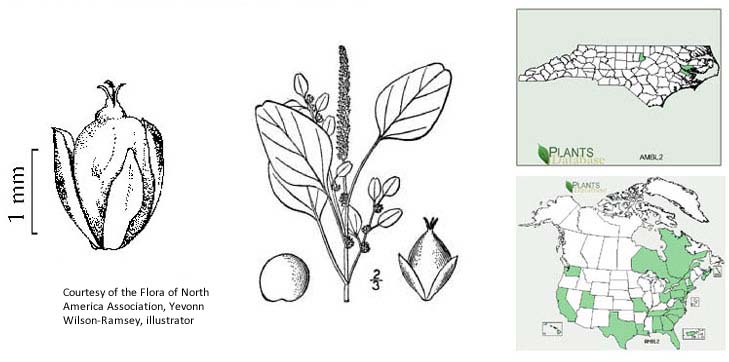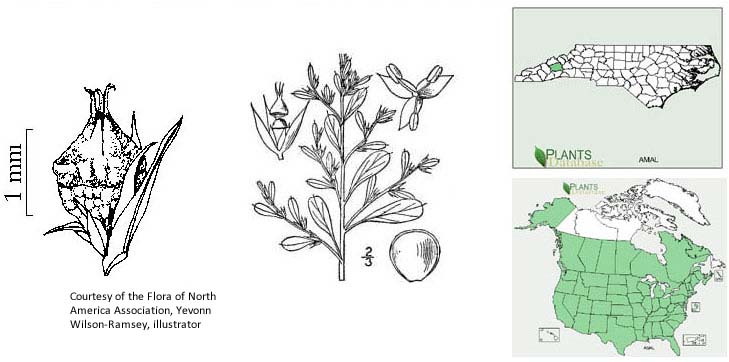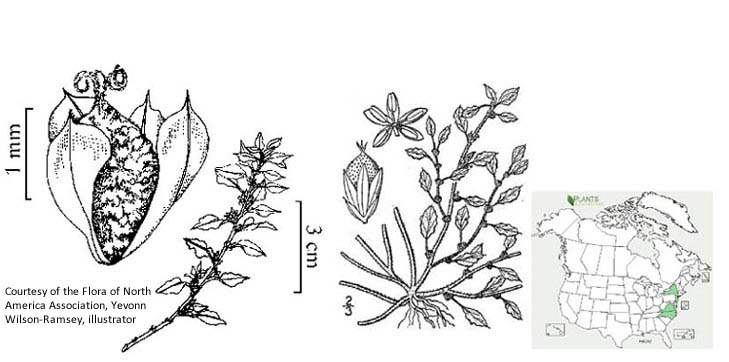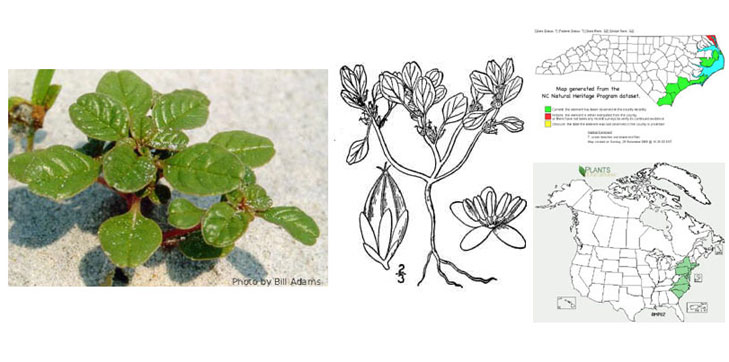Amaranthus L. (Amaranthaceae)
In North Carolina, Amaranthus is represented by fourteen species, of which only two are native—A. cannabinus and A. pumilus (Fed T, S2 G2).
The latter is one of only three federally listed annuals in North Carolina, the other two being Aeschynomene virginica and Ptilimnium viviparum.
Federally listed taxon—
Amaranthus pumilus (Fed T, State T | S1 G2)
Habitat. Open flats on accreting ends of barrier islands, lower foredunes, upper portions of noneroding beaches, or (occasionally) soundside beaches.
Range. Mid-Atlantic states to New England.
Additional resources. NHP | Recovery plan | 5-yr review
Key to Amaranthus in North Carolina
Key adapted from Mosyakin and Robertson (2004 [FNA]) and Weakley (2008). Line drawings from Britton & Brown (1913), unless otherwise indicated. Maps courtesy of USDA PLANTS and the North Carolina Natural Heritage Program.
1. Inflorescences of terminal spikes or panicles, leafless or nearly so at least in the upper portions (axillary spikes or clusters typically also present)...[numerous spp., none of conservation concern in North Carolina]
1’. Inflorescences of axillary clusters of glomerules (leafy terminal spikes sometimes also present)...2.
2. Pistillate flowers typically with 3 tepals; utricles indehiscent (A. blitum) or dehiscing regularly (A. albus)...3.
3. Utricles indehiscent; leaf blades usually deeply notched at the tip...A. blitum 
 Amaranthus blitum
Amaranthus blitum
(uncommon [exotic]; disturbed areas; Pd, CP)
3.’ Utricles dehiscent; leaf blades obtuse, acuminate, or very shallowly notched at the tip...A. albus 
 Amaranthus albus
Amaranthus albus
(uncommon [exotic]; disturbed areas and agricultural fields; Mt)
2’. Pistillate flowers typically with (4–) 5 tepals; utricles indehiscent or dehiscing tardily...4.
4. Leaf margins crisped-erose, conspicuously undulate; utricles 1.5–2 mm long...A. crispus 
 Amaranthus crispus
Amaranthus crispus
(rare [exotic]; disturbed areas; CP)
4’. Leaf margins plane or slightly undulate; utricles 4–6 mm long...A. pumilus* 


Habitat and habit of Amaranthus pumilus (Photo: Krings)

Habit of Amaranthus pumilus (Photo: Krings)

Stem and leaves of Amaranthus pumilus (Photo: Krings)

Leaves of Amaranthus pumilus (Photo: Krings)

Leaf of Amaranthus pumilus (Photo: Krings)

Leaf apex of Amaranthus pumilus (Photo: Krings)

Flower of Amaranthus pumilus (Photo: Krings)
Amaranthus pumilus*
(rare [Fed T, S1 G2]; sea beaches, fore dunes, island end flats; CP; summer to early fall)




